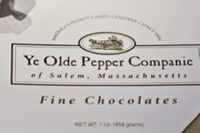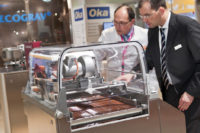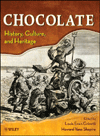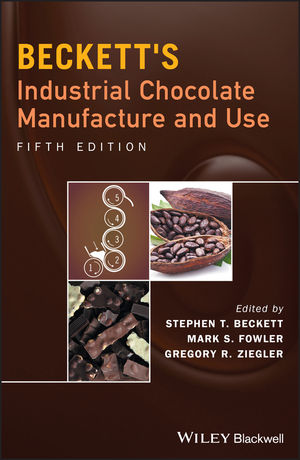Most child-rearing experts agree sharing doesn’t come naturally to kids; that youngsters are not mature enough to grasp the concept, much less comprehend the joys connected with the selfless practice.
Fortunately, by the time they reach adulthood, those same children often are willing and eager to share, especially if it’s chocolate.
As Rich Keller, v.p. of global marketing for Godiva Chocolatier points out, “We saw some white space opportunities involving sharing.”
More importantly, those opportunities came from Godiva customers.
“We spend a good amount of time with a group of 400 women, whom we talk to 24/7 using social media,” he says. “Everyone knows that consumers today are time-starved. They all want convenience and simplicity in their lives.
“Our research also indicated that consumers wanted more Godiva,” Keller adds.
Thus, when Godiva Chocolatier launched its Gems and large bar program in 2009, it did so to make Godiva products more accessible to a larger group of consumers. Priced between $3.99 to $4.99, the twisted-wrapped truffles, available in three distinct varieties — Truffles, Caramels and Solids — found their way into grocery chains, drug store chains and mass merchandisers. Together with the large 3.5-oz bars, the new lineup struck a chord regarding access and value.
Last year, Godiva Chocolatier saw a 48% increase in its Gems business, says Rick Tyrrell, v.p. – North American wholesale. Such numbers affirmed the success of the company’s “most significant global launch,” one that expanded its depth and breadth within the premium category.
It was that success, however, that prompted Godiva Chocolatier to dig deeper into the Gems proposition and see if the company could improve on it.
“My motto is to move fast and improve along the way,” Keller says. Thus, when Godiva’s core customers told the company that sharing chocolates is part and parcel of the chocolate experience, it signaled an opportunity.
To illustrate sharing, the company decided to emphasize a candy bowl on its packaging, an easily identifiable symbol of hospitality. At the same time, consumer research suggested that the shape of the Gems — round truffle-like pieces — weren’t necessarily as important as the flavor and quality of the product. Finally, consumers, when asked about the Gems name, indicated that although the moniker was catchy, it wasn’t critical to the purchase. What was important was the Godiva brand.
After almost a year of consumer and company research and testing, the company re-launched its individually wrapped products and larger bars this spring. The new Godiva truffles come in standup bags that prominently showcase a candy bowl. In addition, the product itself now boasts a flatter half-shell shape, one that shows much more of the center.
“In all the research we’ve done on truffles, consumers tell us that it’s not about the shape, it’s about what’s inside,” Keller says.
Interestingly, testing of the new shape revealed that consumers reported a better eating experience, despite there being no change to the recipe nor to the quantity of the chocolate or centers.
“It just delivers differently, with regards to texture, feel and taste,” says Tyrrell.
After being told that consumers wanted more accessible Godiva, the challenge for the company was to find the right package for the right channel.
By combining standup bags with large bar formats, Godiva Chocolatier also addresses two different eating occasions, Keller points out.
“The wrapped chocolate pieces act as a magnet for sharing,” he adds. “At the same time, it’s also great for a self-treat.”
To further cue the consumer on how to use the chocolates, the new standup pouches prominently feature a candy bowl containing the twist-wrapped chocolates and also include a close-up of the truffle itself, the centers clearly in view.
The bars, however, suggest an in-home, personal experience.
“When you open a bar, it’s something that you would share mostly with people you know and love,” Keller says.
By marrying both propositions, at-large sharing and intimate sharing, the company saw this “brand blocking” strategy as a wonderful way to reinforce the premium stature of the Godiva brand.
“The creamier eating experience behind our individually wrapped truffles brings the consumer closer to the brand’s equity, which is a premium chocolate,” he emphasizes.
To reinforce that Godiva equity and heritage, the back of the package features an image of Godiva Chocolatier’s original shop. Within the package, there’s a booklet that entices the consumer to join the company’s loyalty program, one that rewards membership with a free truffle, available, of course at one of Godvia’s 400 retail boutiques worldwide.
In addition, there’s also a coupon to lure the customer back to the grocer, drug store chain or local retailer.
“It’s a way of rewarding our customers for purchasing our chocolate,” Keller says.
The large-sized bars have also undergone a packaging redesign. Color-coordinated to reflect the relationship between the individually wrapped chocolates, the bars continue to have rich brown tones as part of the premium presentation.
In either case, be it the individually wrapped chocolate or the large bar, it’s all a matter of giving the consumer choices and value.
“We want to deliver the right product in the right channel with the right package,” adds Keller.
Admitting that the launch of Godiva individually wrapped truffles and large bars “redefined the category in a certain way,” by bringing premium into the mainstream, Keller says the move allowed consumers to get Godiva products more conveniently and at a great value.
At the same time, the most recent re-launch introduces new consumers to the Godiva experience, that of Belgian chocolate and its premium credentials.
As Tyrrell points out, “Our brand research shows us that the quality perception of Godiva today is stronger than it was several years ago.”
Moreover, the premium chocolate segment continues to grow, with SymphonyIRI data showing a 7% uptick for last year. Godiva Chocolatier posted a 61% increase for the same period.
“I see it as a challenge to make Godiva more accessible to consumers,” says Keller. “I often use the Apple model as an example. First, they get you to buy an iPod, then an iPad, then an iPhone. Eventually you’ll buy a Mac.”
For Godiva, the path begins with individually wrapped chocolates and extends to the famous gold box. But unlike the Apple model, all of Godiva’s products can be shared.










